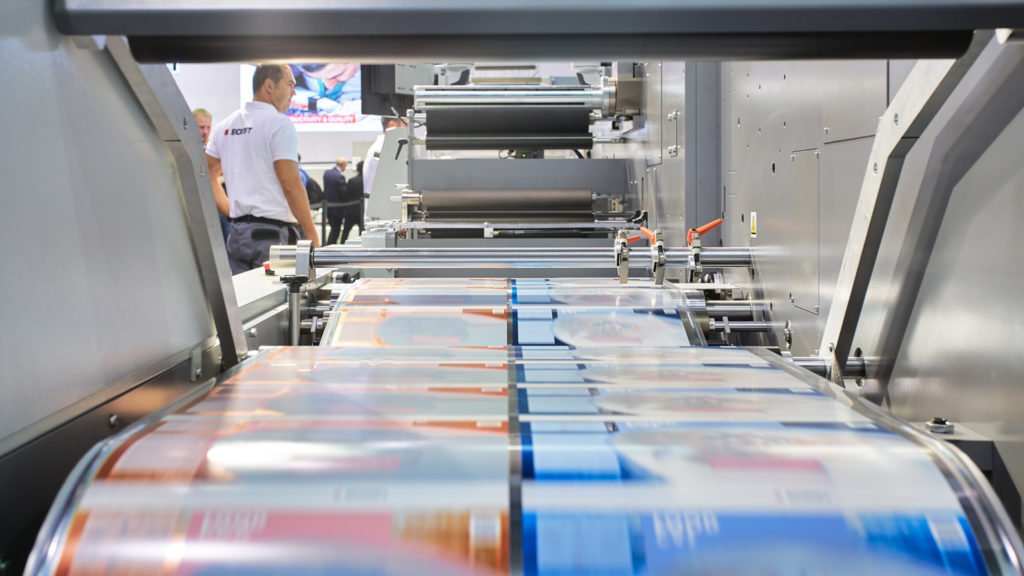Packaging printing refers to applying text, graphics or images to packaging materials using various printing technologies. Printing on packaging enhances shelf appeal, provides information to customers and protects brand identity. There are several printing methods used in packaging industry depending on the packaging material and end use of packaging.
Flexography Printing
Flexography or flexo printing is one of the most commonly used printing methods in packaging due to its ability to print on a variety of substrates at high speeds. In flexo printing, ink is transferred from image carriers called photopolymers or flexographic printing plates to the substrate using anilox rolls. The anilox rolls meter out a precise amount of ink which is then transferred to the substrate. Flexo printing is suitable for printing on thin films, paperboards, corrugated boards and other flexible packaging materials. It can print multicolored designs at high resolutions. Some key advantages of flexo printing include compatibility with porous and semi-porous substrates, ability to print on thin films and ability to print large quantities at high speeds.
Gravure Printing
Gravure printing uses intaglio Packaging Printing plates with images recessed below the non-image areas. These recessed cells are filled with ink which is then transferred to the substrate under pressure. Gravure printing produces consistent, vibrant images at high speeds and long print runs. It is mainly used for printing on blister packaging, shrink sleeves, foil stamps and other high-quality packaging. Special features like embedded security threads and holographics can also be achieved through gravure printing. Some drawbacks include high cost of gravure cylinders and inability to print short print runs economically.
Digital Printing
Digital printing methods use electronic signals and digital imaging to transfer variable or on demand images directly onto packaging substrates without the need for printing plates or cylinders. Popular digital printing technologies used in packaging include inkjet printing, electrophotography (toner based printing) and thermal transfer overprinting. Advantages of digital printing include versatility, short runs, on demand customization and reduced spoilage. Digital printing is well suited for short runs, samples, personalized and versioned packaging. However, costs may be higher for longer print runs compared to conventional methods.
Screen Printing
Screen Packaging Printing uses a stencil made of a finely woven fabric, coated with an impermeable substance except for the image areas, as a printing form to transfer ink to the substrate. It is commonly used for printing graphics, brands and information on rigid containers, bottles and other 3D packaging. Screen printing can produce vivid graphics, spot colors and opaque coatings. With screens, multiple colors and layers can be printed to reproduce complex packaging designs. It has limitations in terms printing on porous or flexible substrates.
Label Printing
Labels provide important product information to consumers and help brands stand out on shelves. Self-adhesive labels are digitally or flexographically printed and laminated or coated before being applied to product packaging. They are used extensively on food, beverage, cosmetic and consumer goods packaging. Digital label printing enables on demand short runs for versioned packaging while flexo label printing is suitable for high volume product lines. Shrink sleeves which shrink to fit containers tightly after application are another popular label format used for branding beverage bottles and cans.
Emerging Printing Technologies
Newer packaging printing technologies continue to emerge aiming to address limitations of existing methods. Inkjet is emerging as a viable process for flexible packaging applications. Advances in ink chemistry and printhead design now enable high resolution color printing at production speeds. 3D printing or digital embossing allows creation of raised textures and complex surface patterns for enhanced product experiences. Printing on alternative substrates like edible and dissolvable films opens opportunities for innovative on-package and on-product branding. Sustainable printing methods focused on reduced ink and chemistry usage will also drive future developments in packaging decorating.
*Note:
1. Source: Coherent Market Insights, Public sources, Desk research
2. We have leveraged AI tools to mine information and compile it



